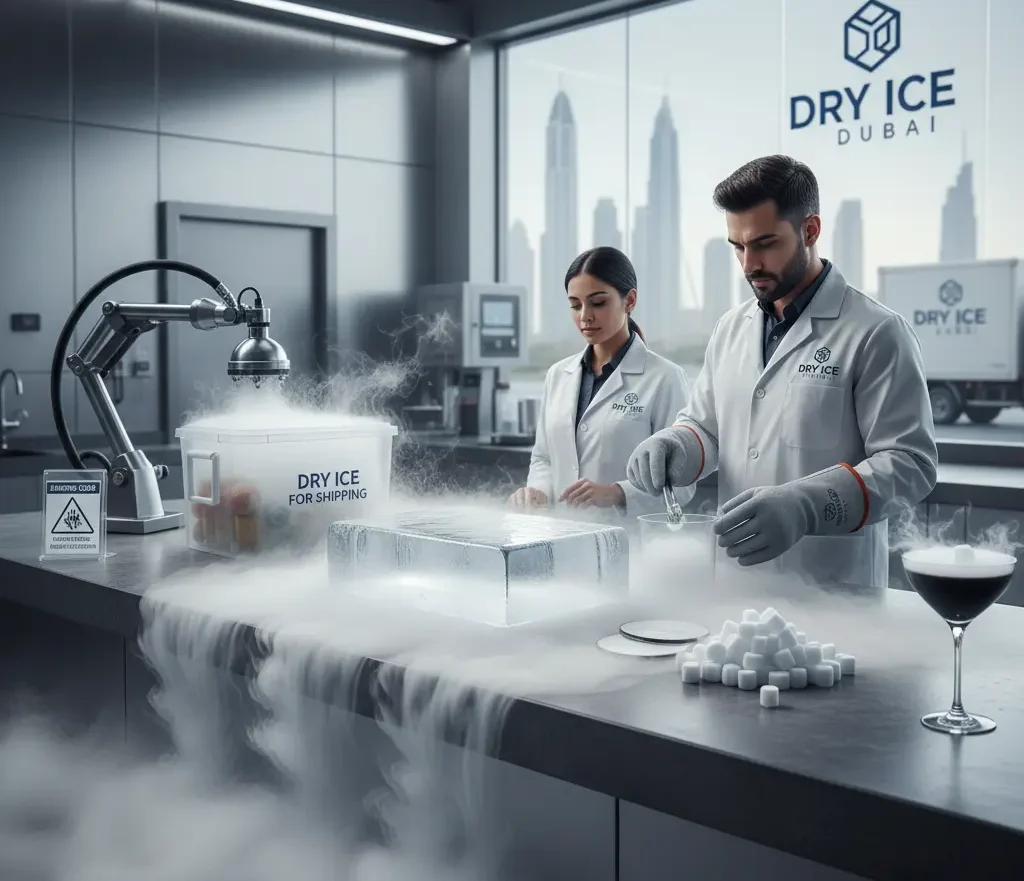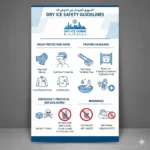What is Dry Ice?
Often seen creating dramatic fog effects or keeping perishables perfectly frozen, dry ice is far more than just “frozen water.” It’s the solid form of carbon dioxide (CO₂), renowned for its extreme cold temperature of -78.5°C (-109.3°F) and unique property of sublimation – transforming directly from a solid to a gas without passing through a liquid phase. This fascinating characteristic is not only why it’s called “dry ice” but also what makes it incredibly versatile and powerful for various applications.
But what dry ice is made of? It’s simply carbon dioxide. Gaseous CO₂ is compressed and cooled until it turns into a liquid, then allowed to expand rapidly, which causes it to solidify into snow-like particles. These particles are then compressed further into the familiar blocks, pellets, or slices we use every day.
Understanding Dry Ice: How it Works and Its Formation
The magic of dry ice lies in its sublimation process. Unlike ordinary ice (frozen water) which melts into a liquid, when dry ice melts, it turns directly into a gas. This is because at standard atmospheric pressure, carbon dioxide cannot exist as a liquid. This transition when dry ice sublimes releases a dense, cold fog when exposed to moisture (like water), which is actually condensed water vapor, not CO₂ gas itself.
How dry ice is formed involves a precise industrial process:
- CO₂ Capture: Carbon dioxide is captured from industrial processes, often as a byproduct.
- Compression & Liquefaction: The gas is compressed and cooled until it turns into liquid CO₂.
- Expansion & Solidification: This liquid is then allowed to rapidly expand in a controlled environment, causing it to flash freeze into solid CO₂ snow.
- Compaction: The CO₂ snow is then compacted into different forms like dry ice blocks, dry ice pellets, or dry ice slices.
This process highlights why dry ice is so effective: it provides powerful, consistent cooling without leaving behind any wet residue, making it an ideal choice where moisture is undesirable.
The Diverse Uses of Dry Ice: More Than Just Fog
Dry ice is an indispensable tool across a multitude of industries and applications in Dubai and the UAE. Its extreme cold and “dry” nature make it superior to regular ice in many scenarios.
Food & Beverage Preservation:
- Shipping & Logistics: Perfect for dry ice for shipping temperature-sensitive goods like seafood, meat, and frozen foods. Will dry ice keep ice cream frozen? Absolutely! It maintains much colder temperatures than regular ice, ensuring integrity during transit.
- Catering & Food Presentation: Create stunning dry ice for food presentation effects with a gentle, smoky mist, enhancing the dining experience for cocktails and buffets.
- Camping & Outdoor Events: Keep food and drinks frozen longer in a cooler with dry ice. It’s far more efficient than water ice.
Medical & Pharmaceutical Transport:
- Crucial for maintaining the cold chain logistics of vaccines, organs, blood samples, and pharmaceuticals. Our medical-grade dry ice ensures critical biological materials remain at ultra-low temperatures during transport, safeguarding their efficacy.
Industrial Cleaning & Blasting:
- Dry ice blasting utilizes high-velocity 3mm dry ice pellets to remove paint, grease, rust, and contaminants from machinery and surfaces. This method is non-abrasive, non-toxic, and leaves no secondary waste, making it an eco-friendly and highly effective solution for industrial cleaning Dubai.
Events & Special Effects:
- From creating a mystical, low-lying fog for weddings, concerts, and theatrical productions to adding dramatic dry ice for party atmospheres, its visual effects are unmatched. Dry ice for smoke effect DIY is popular for Halloween and themed events.
Scientific & Research Applications:
- Used in laboratories for flash freezing samples, creating cold traps, and simulating extreme cold environments.
Safety First: Are Dry Ice Fumes Dangerous? What You Need to Know
While incredibly useful, dry ice must be handled with care due to its extreme cold and sublimation properties. Understanding dry ice safety is paramount.
- Extreme Cold (Burns): Dry ice can cause severe frostbite. Always wear insulated gloves when handling it. Can dry ice burn you? Yes, it causes “dry ice burns” which are similar to frostbite and can be permanent if exposure is prolonged. Never touch dry ice without gloves.
- Ventilation (Fumes/Vapors): As dry ice sublimes, it releases CO₂ gas, which is heavier than air. In enclosed spaces, this can displace oxygen. Are dry ice fumes dangerous or toxic? While CO₂ itself isn’t toxic in the way poison is, high concentrations can lead to suffocation. Always use dry ice in well-ventilated areas. Are dry ice fumes safe? Only in well-ventilated spaces. Are dry ice vapors harmful? Yes, if oxygen levels are reduced.
- Storage (Explosion Risk): Never store dry ice in airtight containers. As it sublimes, the buildup of CO₂ gas can cause the container to burst or explode. This is why dry ice can explode if improperly stored.
- Ingestion: Can dry ice be used in drinks? Yes, but with extreme caution and in small quantities where it quickly sublimes. Never directly ingest or swallow dry ice. Can you eat dry ice? Absolutely not. Can you drink dry ice? Only indirectly, if it’s completely sublimated in a well-ventilated drink (e.g., for a smoky cocktail effect, but not consumed directly).
- Disposal: Allow dry ice to sublimate in a well-ventilated area. Never dispose of it down a drain or toilet, as it can cause pipes to freeze and burst.
Dry Ice vs. Other Cooling Agents: Why Choose Dry Ice?
When it comes to chilling and freezing, you have options. But are dry ice and ordinary ice same? No, they are fundamentally different.
Dry Ice vs. Regular Ice:
- Temperature: Dry ice is -78.5°C; water ice is 0°C. Dry ice provides significantly colder temperatures.
- Residue: Dry ice sublimes, leaving no liquid. Regular ice melts into water. This is a key reason why dry ice is more effective for certain applications.
- Duration: Dry ice lasts much longer than an equivalent amount of regular ice in similar conditions.
- Efficiency: Dry ice has a much higher cooling capacity per pound.
- Usage: For simple cooling or drinks where water residue is fine, regular ice works. For extreme cold, no moisture, or dramatic effects, dry ice is superior.
Dry Ice vs. Liquid Nitrogen:
- Temperature: Both are cryogenic. Liquid nitrogen is even colder at -196°C (-320°F).
- Form: Dry ice is solid CO₂. Liquid nitrogen is a liquid element.
- Handling: Liquid nitrogen requires specialized storage and handling due to its extreme temperature and potential for rapid expansion (much greater than CO₂).
- Cost & Availability: Dry ice is generally more accessible and less expensive for many common applications. Liquid nitrogen is typically for highly specialized industrial or scientific uses.
- Safety: Both require rigorous safety protocols, with liquid nitrogen often needing more advanced precautions.
Dry Ice Dubai: Your Premier Dry Ice Supplier in Dubai and Across the UAE
When you need reliable, high-quality dry ice in Dubai or anywhere in the UAE, look no further than Dry Ice Dubai. With 20+ years of expertise in cryogenic solutions, we are committed to providing the best products and services with unparalleled safety and efficiency.
We offer:
- Certified Food & Medical Grade Dry Ice: Ensuring the highest purity for sensitive applications.
- Wide Range of Products: From dry ice blocks (40mm, 70mm, 140mm) for prolonged cooling, to versatile dry ice pellets (3mm, 10mm, 16mm) for blasting and flash freezing, and precise dry ice slices (22mm, 28mm, 60mm) for controlled cold chain.
- Hassle-Free Delivery: Enjoy same-day dry ice delivery in Dubai and next-day delivery across the UAE. We’re your most convenient “dry ice near me” solution.
- Competitive Pricing: Get the best dry ice prices in Dubai without compromising on quality or service.
- Liquid Nitrogen Supply: Beyond solid CO₂, we are also a leading liquid nitrogen supplier in Dubai, providing high-purity LN2 and specialized storage tanks.
Whether you’re organizing an event, transporting critical medical supplies, preserving food, or conducting industrial cleaning, Dry Ice Dubai has the expertise and products to meet your specific requirements. We pride ourselves on creating helpful, reliable, people-first content and services, ensuring you have a satisfying experience every time.
Frequently Asked Questions (FAQs) About Dry Ice
What is dry ice and why is it called dry ice?
Dry ice is the solid form of carbon dioxide (CO₂). It’s called “dry ice” because it sublimes, meaning it turns directly from a solid into a gas without becoming a liquid, leaving no wet residue.
Is dry ice dangerous?
Yes, dry ice can be dangerous if not handled properly. Its extreme cold (-78.5°C) can cause severe frostbite, and the CO₂ gas it releases can displace oxygen in poorly ventilated areas, leading to suffocation. Always wear insulated gloves and ensure good ventilation.
Can dry ice burn you?
Yes, direct contact with bare skin can cause frostbite, similar to a burn, due to its extremely low temperature. Always use thick gloves or tongs to handle dry ice.
How long does dry ice last?
The sublimation rate of dry ice depends on factors like temperature, humidity, and insulation. Typically, 10 pounds of dry ice can last 18-24 hours in a well-insulated cooler. Pellets sublimate faster than blocks.
Can I store dry ice in my home freezer?
You can, but it’s not ideal. Standard freezers are not cold enough to stop dry ice from sublimating. Store it in a well-insulated cooler, preferably with good ventilation, and never in an airtight container due to explosion risk. It will also cause your freezer to work harder and may even damage it.
What is dry ice made of?
Dry ice is made solely of carbon dioxide (CO₂).
How is dry ice formed?
Gaseous carbon dioxide is pressurized and cooled to become liquid CO₂. This liquid is then allowed to expand rapidly, causing it to freeze into CO₂ snow, which is then compressed into blocks, pellets, or slices.
Can dry ice be used in drinks or for food?
Yes, food-grade dry ice can be used cautiously to create fog effects for drinks and food presentations. However, it should never be consumed directly. Ensure it fully sublimes before drinking or eating, or use special dry ice stirrers/chambers.
What are dry ice fumes? Are they toxic?
Dry ice “fumes” are actually carbon dioxide gas released during sublimation. While CO₂ itself is not toxic like a chemical poison, high concentrations can be harmful by reducing oxygen levels, leading to dizziness, headache, or even suffocation in poorly ventilated spaces.
Can dry ice melt into water?
No, dry ice does not melt into water. It sublimes, turning directly into carbon dioxide gas. If you see “smoke,” it’s condensed water vapor from the air, not liquid CO₂.
Where can I buy dry ice near me in Dubai?
Dry Ice Dubai is your trusted supplier for high-quality dry ice in Dubai and across the UAE. We offer same-day delivery and various forms (blocks, pellets, slices) for all your needs. You can order directly from our website or contact us via phone/WhatsApp.






